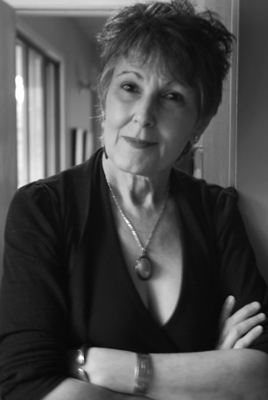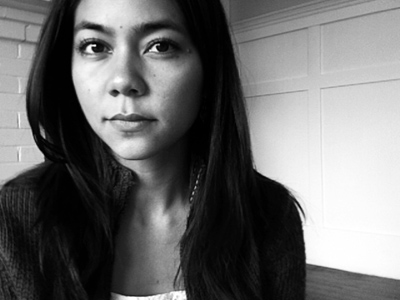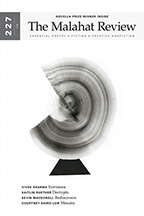Interviews
Writing Back to the Self: Corinna Chong in conversation with Eve Joseph
 Eve Joseph talks with Malahat volunteer Corinna Chong about "Intimate Strangers" (#173, Winter 2010), winner of The Malahat Review's 2010 Creative Non-Fiction Prize.
Eve Joseph talks with Malahat volunteer Corinna Chong about "Intimate Strangers" (#173, Winter 2010), winner of The Malahat Review's 2010 Creative Non-Fiction Prize.You are an accomplished writer of both creative non-fiction and poetry. How does the process of writing prose differ from that of poetry?
I suppose the most immediate difference is that there is more room to explore with prose. My natural tendency in writing is towards precision; I would love to write in a looser, less contained way, but I am drawn to a kind of exactness, particularly in poetry. Prose breaks the line open and lets me keep going. I think I tap into imagination in a different way; with poetry, memory is often related to specific imagery whereas with prose I think there is a fluidity to memory. One holds a moment; the other tends toward story.
The idea of memory as a bridge to self-understanding plays a prominent role in “Intimate Strangers.” What role do memories play in your work as a writer?
I don’t know how to separate memories from writing or if one can even do that. I don’t think I start out trying to write about a certain memory; rather, I start out often by observing something in the physical world or mulling some idea and I am then led back into specific memories. I try to stay open to associations and to trust that one thing leads to another. I love how the act of writing unearths memories and how I never know, when I start a piece, where I will end up. Writing, in my experience, is a way back to the self.
The story suggests, “In North America, we don’t quite know what to do with our dead.” What kinds of consequences do you think this may have on the way our culture deals with loss and grief?
The biggest consequences may be loneliness and isolation. For the most part, death and dying are invisible to us; we have given over care of the dying and the dead to professionals with the result that we are, in my opinion, estranged from death. It is no longer common practice for us to wash and dress our dead or hold wakes in our living rooms; we don’t know how to claim our dead or how to talk about them. The therapeutic language of recovery and healing has seeped into our thinking about death; we are encouraged to “let go” and to seek “closure” but we don’t have a language of ongoing relationship, a language that embraces our loved ones and lets us maintain a relationship with them. Death and dying are denied description in North America because they are denied expression.
The imagery of the gorilla cages that the narrator sees outside her brother’s apartment seem to resonate with the story’s portrayal of the living body as a kind of prison from which the dying seek to escape. Can you comment on this connection?
That’s an interesting connection; one that I didn’t consciously make when I wrote the piece. The idea of a cage is both literal and metaphorical. The ones at my brother’s place were built to confine gorillas; the body, too, is a kind of container. I’m not sure prison is the right word; I think it might be more accurate to see the body as a temporary shelter. A place that houses us for the time we are here. Many people, in their last days, struggle with how they will leave and how they will know where to go. Interestingly, this can happen for people with strong religious faith as well as for atheists. It is not so much escape as it is a sense of timing; people often repeatedly ask the time or want to know if a loved one is going with them. Departure is in the air.
Cultivated gardens and flowers follow in death’s trail throughout the story. Do you see a relationship between cultivation and the process of dying?
The analogy of a garden is a good one. We cultivate gardens but also revel in their wildness: birds drop seeds, an overnight frost kills new shoots, a cold spring goes on endlessly…all these things point to the fact that we don’t have control. The garden takes its own shape regardless of how much we tend it. I think this is true, as well, with dying. There is a great deal of pressure these days to have “a good death.” When I worked at hospice, I met people who worried that they were failing at their own deaths: some who didn’t feel ready to die, others who were frightened and felt unprepared. “Dying is an art like everything else,” wrote Sylvia Plath. To my mind, there is no ideal death, there is only our own death and what we each bring to that experience. Amongst other things, “to cultivate” means to make friends with; perhaps that is one way of thinking about the process of dying.
How does writing poetry immerse you in the state of awareness or “taste of the self” that you experienced while working at hospice?
I worked at hospice for twenty years during which time I wasn’t writing; when I came back to poetry I was amazed at the similarities between working with the dying and the process of writing poetry. Both things required my full presence; whatever I thought I knew about dying or poetry needed to be put aside in order to simply be there: to be open and responsive to whatever presented itself. Stanley Kunitz writes: “the poet doesn’t so much disappear into the poem as become the poem. It is a concentration of faculties, of everything you are or hope to be.” For me, the moments when I feel I am a vehicle for something are true gifts. Moments when it feels as if poetry comes through me and not from me.
What made you decide to write this story as a creative non-fiction piece rather than a fictional story or poem?
The risk in writing about dying is that of sentimentality. I wanted a genre that could contain stories and fragments in a way that didn’t feel precious. I have tried writing about death in verse but few of the poems work. When I wrote The Startled Heart, a book of ghazals about death and dying, it was the fragmented, associative nature of the form that allowed me to write them without the weight of narrative. I am also drawn to the way creative non-fiction can hold many things simultaneously; memory, story, image, history, and personal anecdote all co-exist in a way that feels natural. I am more interested, I think, in drawing on many sources and seeing how they relate than I am in telling a story.

Corinna Chong
* * * * * * * * *
Check out the guidelines for our 2011 Creative Non-Fiction Prize.









